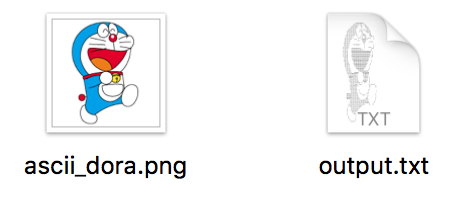Python code
convert a picture to text.
from PIL import Image
import argparse
# turn all of the ascii_char to list ['$', '@', ...., '.']
ascii_char = list("$@B%8&WM#*oahkbdpqwmZO0QLCJUYXzcvunxrjft/\|()1{}[]?-_+~<>i!lI;:,\"^`'. ")
# generate an instance of argument parser
parser = argparse.ArgumentParser()
parser.add_argument('file') # input file
parser.add_argument('-o', '--output') # output file
parser.add_argument('--width', type = int, default = 80)
parser.add_argument('--height', type = int, default = 80)
# acquire arguments
args = parser.parse_args()
IMG = args.file
WIDTH = args.width
HEIGHT = args.height
OUTPUT = args.output
def get_char(r, b, g, alpha = 256):
if alpha == 0:
return ' '
length = len(ascii_char)
gray = int(0.2126 * r + 0.7152 * g + 0.0722 * b)
unit = (256.0 + 1) / length
return ascii_char[int(gray/unit)]
if __name__ == '__main__':
im = Image.open(IMG)
im = im.resize((WIDTH, HEIGHT), Image.NEAREST)
txt = ""
for i in range(HEIGHT):
for j in range(WIDTH):
txt += get_char(*im.getpixel((j, i)))
txt += '\n'
print txt
if OUTPUT:
with open(OUTPUT, 'w') as f:
f.write(txt)
else:
with open("output.txt", 'w') as f:
f.write(txt)
# python it in Terminal
MBP-Ethan:shiyanlou xing$ python ascii.py ascii_dora.png
Here’s the Output.txt

Parse
The key point of this script is:
txt += get_char(*im.getpixel((j, i)))
Using the im.getpixel() method to get the pixel of the Picture.
>>> import Image
>>> import os
>>> os.listdir('.')
['.DS_Store', 'ascii.py', 'ascii_dora.png', 'output.txt', 'test.png', 'utput.txt']
>>> im = Image.open(os.listdir('.')[2])
>>> h, w = im.size
>>> im.getpixel((h/2, w/2))
(255, 255, 255, 255)
>>> im.getpixel((h/4, w/4))
(0, 160, 233, 255)
Then called the get_char() function convert it to character.
def get_char(r, b, g, alpha = 256):
if alpha == 0:
return ' '
length = len(ascii_char)
gray = int(0.2126 * r + 0.7152 * g + 0.0722 * b)
unit = (256.0 + 1) / length
return ascii_char[int(gray/unit)]
Mapping pixel to sequence ascii characters. step by step:
>>> ac = list("$@B%8&WM#*oahkbdpqwmZO0QLCJUYXzcvunxrjft/\|()1{}[]?-_+~<>i!lI;:,\"^`'. ")
>>> ac
['$', '@', 'B', '%', '8', '&', 'W', 'M', '#', '*', 'o', 'a', 'h', 'k', 'b', 'd', 'p', 'q', 'w', 'm', 'Z', 'O', '0', 'Q', 'L', 'C', 'J', 'U', 'Y', 'X', 'z', 'c', 'v', 'u', 'n', 'x', 'r', 'j', 'f', 't', '/', '\\', '|', '(', ')', '1', '{', '}', '[', ']', '?', '-', '_', '+', '~', '<', '>', 'i', '!', 'l', 'I', ';', ':', ',', '"', '^', '`', "'", '.', ' ']
>>> import Image
>>> picPath = '/Users/xing/Documents/shiyanlou/ascii_dora.png'
>>> im = Image.open(picPath)
>>> h, w = im.size
>>> pix = im.getpixel((h/3, w/3))
>>> pix
(45, 31, 34, 255)
>>> length = len(ac)
>>> r, b, g, alpha = pix
>>> gray = int(0.2126 * r + 0.7152 * g + 0.0722 * b)
>>> gray
36
>>> unit = (256.0 + 1) / length
>>> unit
3.6714285714285713
>>> int(gray / unit)
9
>>> ac[9]
'*'
>>>